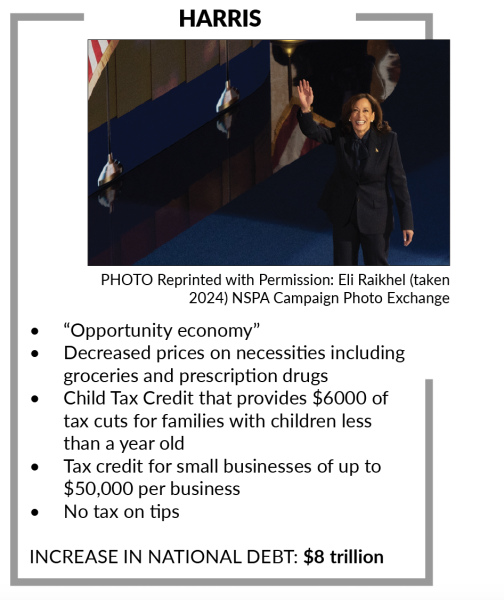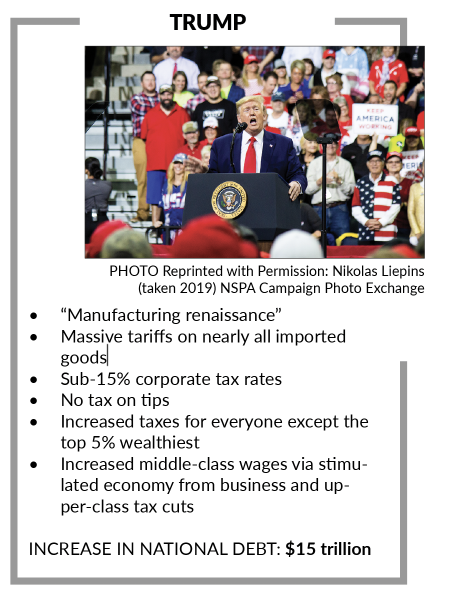Amidst the swarm of issues for voters this election season, the economy has prevailed as the most important subject in the eyes of over 81% of voters. Candidates throw around terms like “opportunity economy” and “manufacturing renaissance,” but what do they mean for voters?

The Harris Plan
After accepting the Democratic nomination for president Aug. 5, Vice President Kamala Harris proposed “an opportunity economy where everyone has a chance to compete and a chance to succeed” in her speech. This pitch encompasses her proposed economic policies, including slashing the prices of necessities such as groceries and prescription drugs and imposing numerous tax credits. In particular, Harris is pushing for the Child Tax Credit that will provide $6,000 worth of tax cuts for families with newborns less than a year old and another tax credit that will allocate $50,000 for small businesses with the hope of having 25 million new small business applications within the first two years of her presidency.
The Trump Plan
While Harris aims to support communities in need, former President Donald Trump has prioritized augmenting American jobs. During his speech at his Sept. 24 rally in Savannah, Georgia, Trump stressed the need to accelerate the manufacturing industry, propagating the idea of the U.S. undergoing a “manufacturing renaissance” if he were to get elected. His policies include high tariffs on non-American manufacturing companies, with some as high as 200%, corporate tax rates below 15%, abolishing the tax on tips, and deregulation of the manufacturing sector, which empirically means cutting down on excess federal control of the sector, eliminating outdated and inconsistent rules, and getting rid of negative impacts of regulation such as job losses and delays. He also claims to uplift the middle class by increasing middle-class wages and stimulating the economy through increased investments from tax cuts for businesses and the upper class.

The Response
Backlash against both candidates’ plans has remained steady: in response to Harris’ plan, Trump proclaimed, “She doesn’t have a plan. She copied Biden’s plan, and it’s like four sentences, like ‘Run Spot Run.’ Four sentences that it’s just, ‘Oh, we’ll try to lower taxes’” during the presidential debate Sept. 10. Furthermore, Trump has made numerous comments about Harris’s “communist-leaning” economic policies, claiming, “[she] is reportedly proposing communist price control. She wants price controls, and if they worked, I’d go along with it, but they don’t work. They actually have the exact opposite impact and effect” during a press conference in his golf club located in Bedminster, New Jersey.
While Trump has made various snippy comments against Harris’s plan, Harris’s criticisms focus on Trump’s method of reaching his overarching goal: preserving American jobs and workers. In particular, she strikes back against the United-States-Mexico-Canada Agreement (USMCA), a trade deal passed by Trump to replace the North American Free Trade Agreement (NAFTA), asserting that the USMCA does not protect American workers enough. She also declared Trump as “one of the biggest losers of American manufacturing in our history,” referencing the supposed reduction of manufacturing jobs during the Trump administration. At the same time, she targeted other claims against Trump’s use of tariffs as a national sales tax and his policy about executing tax cuts for the wealthy as a way to compensate for the middle class.
The Strategy
Though the candidates intend their economic plans to be a vote-securing strategy, they might only sometimes work in their favor. “[residents of] the industrial Midwest, places that have been left behind by manufacturing didn’t like the free trade NAFTA policies of Clinton in the 1990s. Rolling those back by putting up tariffs is a strategy that I think [Trump’s] hopeful will work the way that it worked in 2016,” History teacher Jon Peterson said. On the other hand, for first-time runner Harris, “she’s kind of in a trickier position, because on the one hand, she’s the incumbent, and on the other hand, she’s running as kind of an outsider.”
Voters often regard the economy as Harris’s Achilles’ heel. “With the [no tax on tips policy in Nevada], Harris immediately adopted Trump’s position after he said it. So you do see tactics like that where Harris, for example, just switches or not switches but adds something to her economic plan to try to level the playing field,” junior Roman Farley said.
Both plans may seem appealing to certain voters, but there are somber downsides; according to the Committee for a Responsible Federal Budget, Harris’s plan would increase the national debt by up to $8 trillion through 2035, whereas Trump’s plan would increase the debt by up to $15 trillion. Furthermore, the Institute on Taxation and Economic Policy estimates that Trump’s policies on reducing taxes for the wealthy and increasing tariffs would result in increased taxes for every person except those who fall under the top five percent in terms of income, detracting from any benefits that may arise if Trump were to get elected.
Opportunity economy. Manufacturing renaissance. Whether the candidates’ plans will have their desired effects remains ambiguous, but after Nov. 5, the nation’s economic future will clear up.